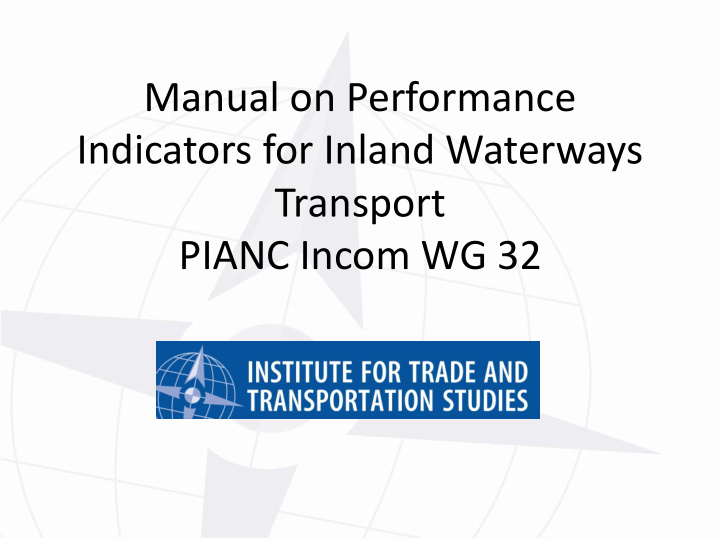



Manual on Performance Indicators for Inland Waterways Transport PIANC Incom WG 32
Waterway Usage- Russia, Europe and U.S., 1970-2006 500 Kilometers Share 450 China 110,000 18% 400 Thousand Million Tonne-Kilometers 350 Russia 102,000 16% 300 250 Brazil 50,000 8% 200 150 United States 41,009 7% 100 Indonesia 21,579 3% 50 0 Colombia 18,000 3% 1970 1990 2000 2006 Russia US EU 26 Vietnam 17,702 3% European Average 52,332 8%
PIANC? • World Association for Waterborne Transport Infrastructure • USACE – National Section • INCOM, MARCOM, RECOM, ENVICOM, YPCOM
InCom WG 32 -Performance Indicators for Inland Waterways Transport • September 2007 Official start of WG 32 • September 2007 Basic study of Performance Indicators General introduction and fundamental theories • September 2008 Intermediate Report • January 2009 New structuring of the contents Elaboration of the Manual • February 2010 Completion of the Final Report Manual on Performance Indicators for Inland Waterways Transport
Terms of Reference • Reflect the critical success factors • Improve the overall performance of inland waterway navigation (IWN) • Set common definitions, standards, and measurements • Encourage industry-wide adoption • Increase attractiveness for users • Technical and non-technical performance criteria • Evaluation of the elements • Development of a list of criteria or indicators for each element to validate • Determination of an assessment method to rank
Objectives of WG32 • Intermodal applicability • Comparability with other transport modes • Performance measurement system appropriate for all kind of inland waterways • Standardized approach (reference model) • Internationally accepted and applied guidelines • Standard reference document used by national administrations
Performance Indicators shall… • affect strategic, tactical and operational planning and control • play an important role in setting goals, evaluating performance and determining future course of action • identify an organization‘s success • analyze whether customer‘s and stakeholder‘s needs are met
6 Steps to Define Performance Indicators • Particularise the necessary basic data • Recommend a potential data source • Describe the calculation method • Explain the measurement unit • Suggest a collection regularity • Define an objective
Performance indicators within the suppy chain C C u u s s t t o o m m e e r r s s Scope of indicators
Areas of Application Mobility and Reliability Ports and Cargo Transhipment and Sites Passengers Safety Fleet and Ports and Vehicles Security Economic ICT Development Environ- ment
Name of the Area of Application Area of application ID Name of the performance indicator Performance indicator ID Description Detailed description of the provided information Calculation Formula that describes how to calculate the performance indicator Terms Definition of terms which are used within the formulas Information Additional information that is necessary for deeper understanding Measure Measurement unit in words 365 Daily 52 Weekly 1 2 3 4 5 6 7 8 9 10 11 12 Monthly Collection 1 2 3 4 Quarterly 1 2 Semi-annually 1 Annually Objective What is the objective that is followed by this performance indicator Comment Further information or comment on the performance indicator Indicates the level of implementation corresponding to the level of complexity of the recommended PI. It is therefore differentiated in three categories: Complexity Level 1 Level 2 Level 3 Indicates the recommended application of the PI within three categories: Application Operation Information Reference
Infrastructure
Ports
Environment
Fleet and Vehicles
Cargo and Passengers
Information and Communication
Economic Development
Safety
Security
PIANC USA • Report will be released later this year • PIANC USA 2010 Annual Meeting September 22,2010 Boston, MA • SmartRivers September 13-16, 2011 New Orleans, USA,
Recommend
More recommend